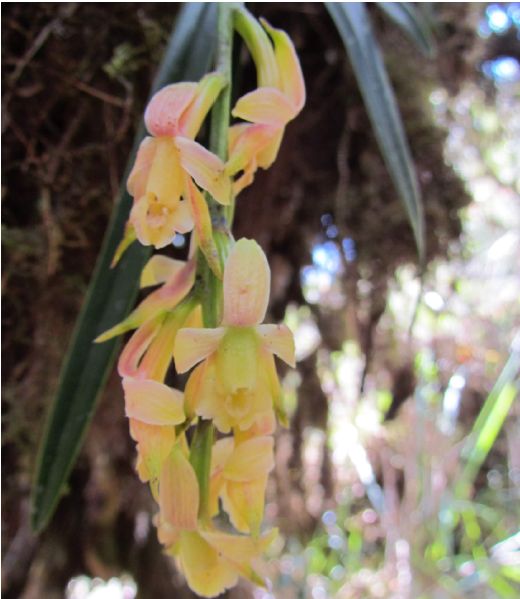

Epidendrum incahuamanii Collantes & Hágsater 2015 GROUP Coronatum SUBGROUP Aristisepalum
TYPE Photo by © Incahuaman/TYPE Drawing by © Collantes and The AMO Herbaria Website



Common Name Incahuaman's Epidendrum [Peruvian worker at the Santuario de Macchu Picchu current]
Flower Size 1.2" [3 cm]
Found in Cusco province of Peru on trees in sphagnum moss in cloud forest as a small to medium sized, cold growing epiphyte with cane-like, terete, new stem arising from the subbasal node of the previous stem, erect, straight stem carrying 5 to 10 all along the apical 2/3's of the stem, distichous, articulate, subcoriaceous, linear-lanceolate, subacute, mucronate, margin transluscent, appearing vitrified, irregularily crenate towards the apex, upper surface green suffused with purple to reddish leaves that blooms in the winter on a terminal, erect, racemose, arching-nutant, peduncle .8 to 1.2" [2 to 3 cm] long, complanate, rachis subtriquetrous, densely, successively 4 to 10 flowered inflorescence with setaceous, the lower ones more than half as long as the ovary, progressively shorter, the apical ones half as long as the ovary, ovate-triangular to ovate acuminate, clasping floral bracts and carrying the resupinate flowers opening from the apex towards the base.
"The whole flower, when chewed is sweet, and therefore is called “misky” in Quechua, which means sweet."
"Epidendrum incahuamanii belongs to the GROUP Coronatum SUBGROUP Aristisepalum, which has a caespitose habit, simple stems, sub-coriaceous leaves, an arching-nutant, racemose inflorescence without spathaceous bracts, a thickened disc on the 3-lobed lip, and especially the lateral sepals which are apically prominently aristate-complanate, .6 to .8" [15 to 20 mm] long. The species is recognized by the linear-lanceolate leaves 1 to 6" x .12 to .36" [2.5 to 15 x 0.3 to 0.9 cm], the lip deeply 3-lobed, lateral lobes dolabriform-subelliptic, oblique, the disc thickened into a semi-circular plate, traversed by a prominent mid-rib extending to the apex of the mid-lobe which is .1 x .24" [2.5 x 6 mm], semi-circular, apex usually retuse. Epidendrum birostratum has wider leaves, 2.6 to 5.2" x .52 to .6" [6.5 to 13 x 1.3 to 1.5 cm], the lip with dolabriform-rounded lateral lobes, mid-lobe as long as the lateral lobes, cuneate, sub-quadrate, the apex sinuous-truncate, 3-dentate; disc with the thickened plate sub-quadrate-ovate. Epidendrum aristisepalum Hágsater & Dodson from southern Ecuador has similar leaves 2.4 to 4.58" x .28 to .44" [6 to 14.5 x 0.7 to 1.1 cm], but the ecallose lip has a sub-orbicular mid-lobe with the disc thickened into 3 prominent longitudinal ribs. Epidendrum jalcaënse Chocce-Peńa, Dalström, Hágsater & J.Arnaiz has wider, shorter leaves, 1.88 to 2.64" x .4 to .6" [4.7 to 6.6 x 1.0 to 1.5 cm], bright orange flowers with a wide, 4-lobed, ecallose lip, with 5 thickened ribs on the disc." Hagsater etal 2015
Synonyms
References W3 Tropicos, Kew Monocot list , IPNI ; Icones Orchidacearum 15 [1] Plate 1504 Hagsater & Sanchez 2015 see recognition section; * Icones Orchidacearum 15 [1] Plate 1527 Collantes & Hágsater 2015 drawing fide; Icones Orchidacearum 16(2) Plate 1699 Hagsater & Jimenez 2018 see recognition section
--------------------------------------------------------------------------------------------------------------------------
--------------------------------------------------------------------------------